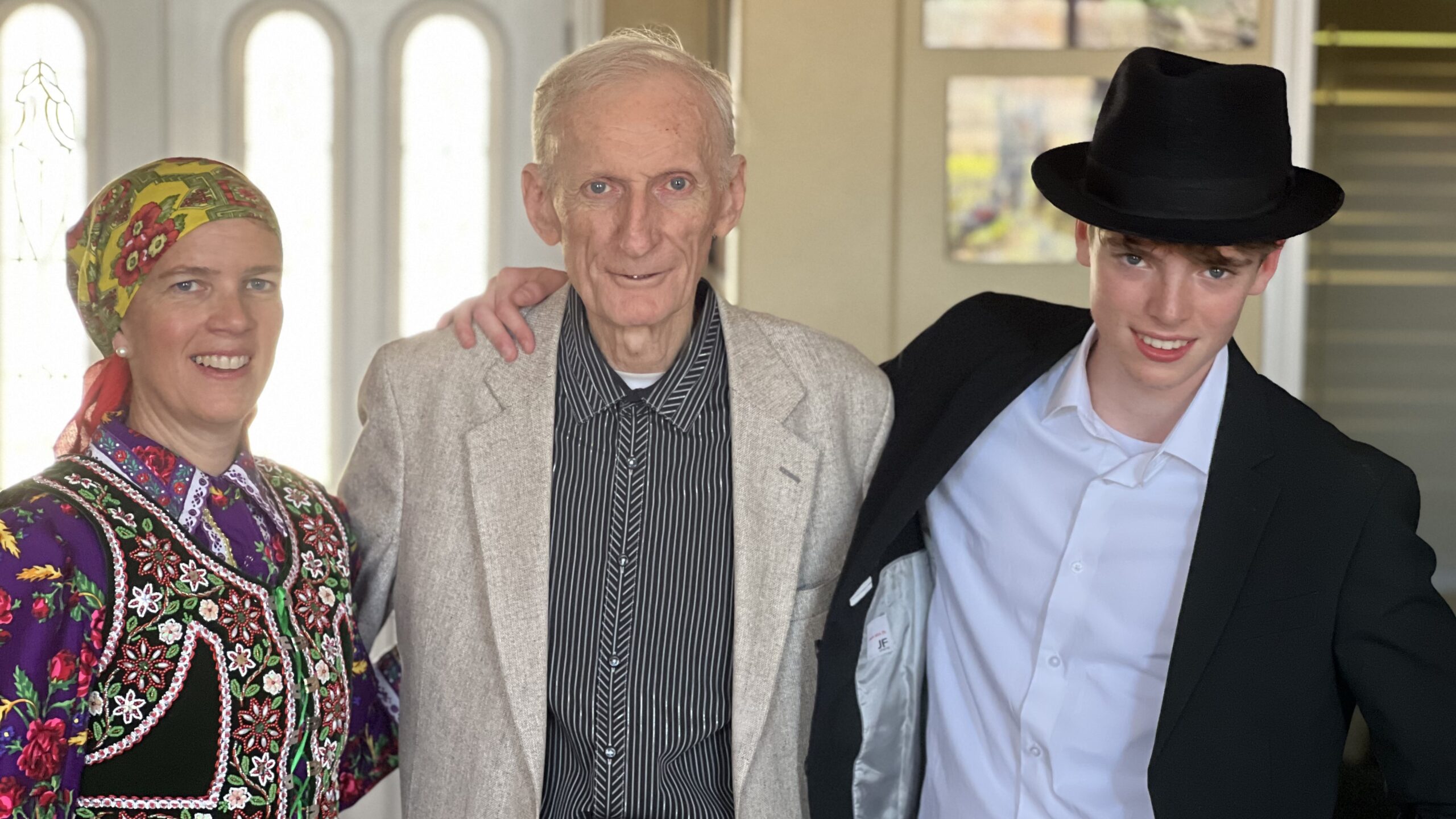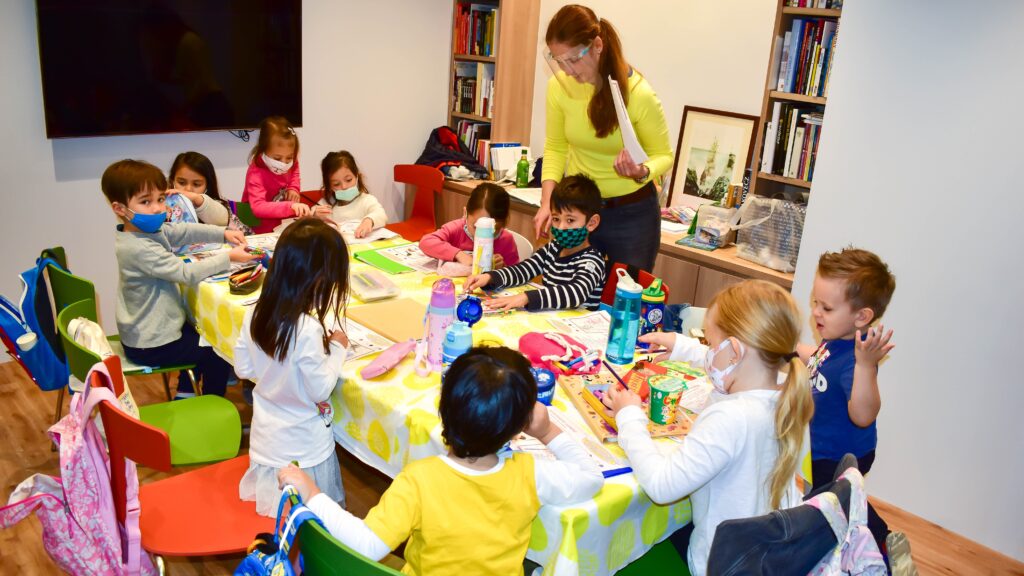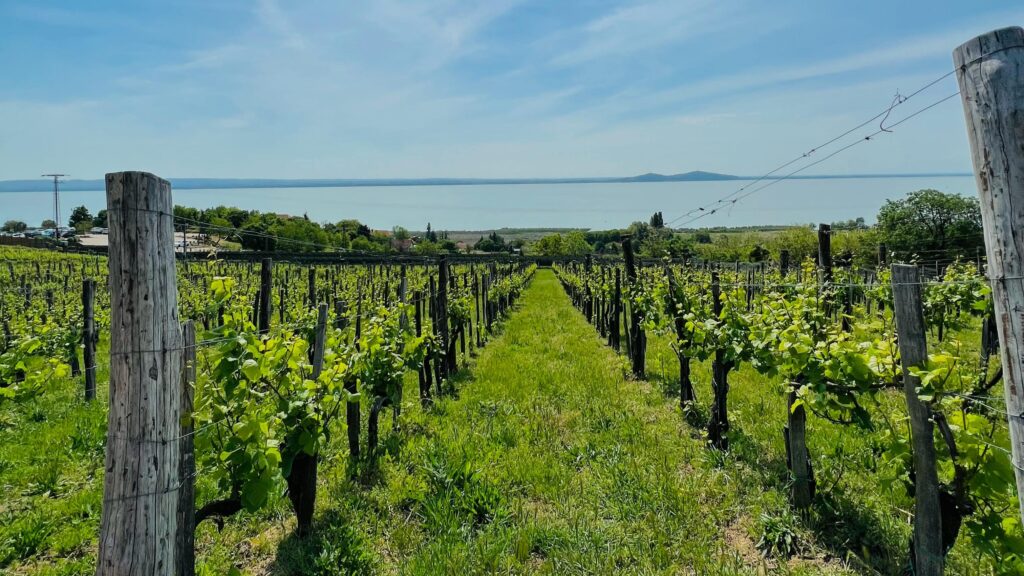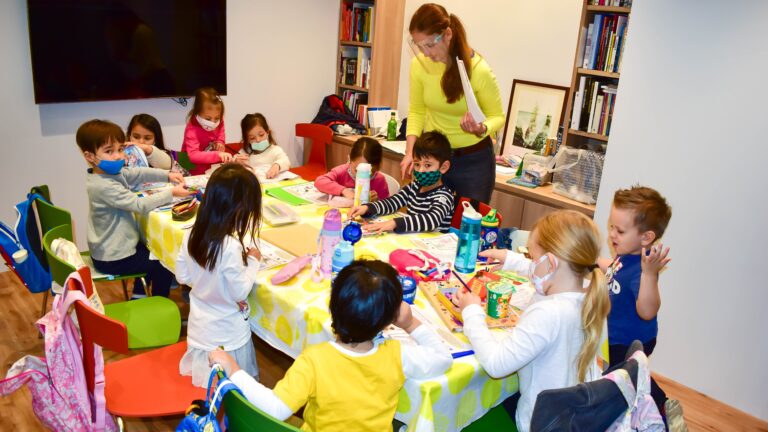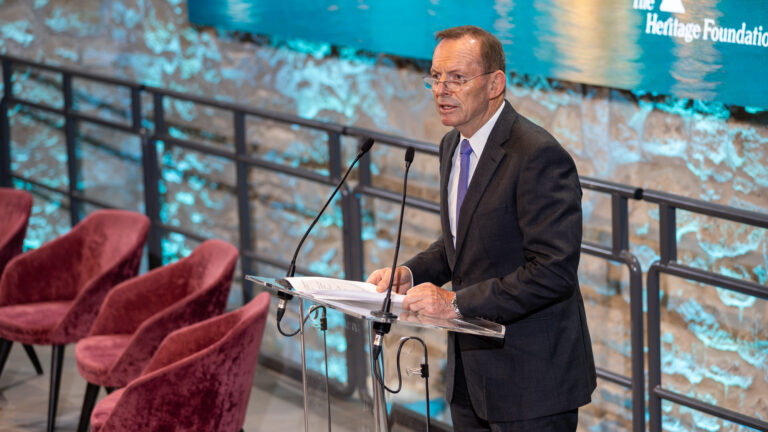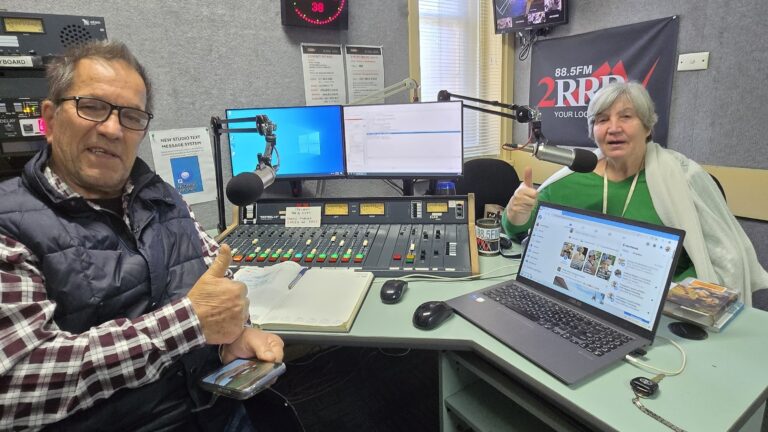Panni De Cheke Qualls was born in Hungary and came to the U.S. as a child with her family in the late 1980s. Her American husband is a significant supporter of her Hungarian volunteer commitments in the diaspora; her son, Leó dances together with her in the Tisza Ensemble and Bátori Folk Dance Ensemble from the Washington, DC–Virginia–Maryland area. Panni is co-founder of the Hungarian Folklife Association (HFA) that has recently established the Folk Ambassador Program as a new Kőrösi Csoma Sándor Program model, starting with Kíra Kertész and Bence Hajdu.
***
How did you end up in America?
My father’s family is originally from Szatmárcseke—hence the anglicized name De Cheke, because no one could pronounce Varjú, especially not in the 1980s. My mother’s family was also from northeastern Transylvania (Sződemeter), and later Sárospatak. My parents met in Budapest, their families had flats in the same building. My brother, Bálint and I were born there.
My family’s story is really average. Like many others connected to the events of 1956, we share a common trauma. My uncles, Tamás and János Demeter, were 16 and 18 years old at the time, enduring the arduous journey across Hungary to the Austrian border. As refugees, they crossed the ocean by boat and landed in the U.S. They were received by several communities including Pittsburgh, Cleveland and others on their way to California, where they settled. My mother and her parents stayed in Hungary. Eventually, my grandparents, Jolán and Károly Demeter, joined their sons. In the late 1980s my father had an opportunity to be a postdoc in Massachusetts. This opened the door to family reunification, which may have crossed my mother’s mind, but not the rest of us in the family. Even when we crossed through Checkpoint Charlie, we never imagined that our flight on the Pan Am 474 would be one-way.
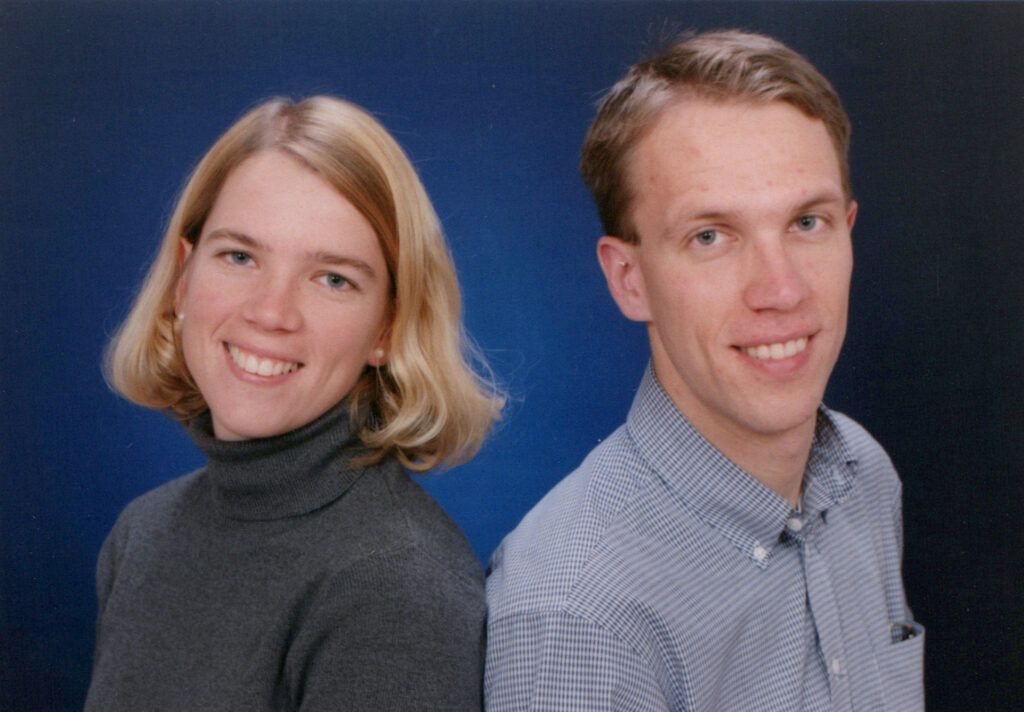
What about your own family?
My brother Bálint and I experienced a somewhat insular childhood because as immigrants we had the ‘we are in one boat’ mentality—us against the world. As we got older, that same world opened up and became much bigger. So much kindness, grace, and wisdom out there. At 22, I knew I was deficient, incomplete and had much to learn about people and how things worked. I was curious and eager to learn. Maybe for these reasons, mentors in my life came along miraculously—always at the right time. Experience in life is the only teacher. Over time, I learned what a privilege it is to be human, and that trusting others, working and being together can lead to a fuller life.
My husband, Ray, is a perfect example of this. I don’t know why the universe decided I deserved such a partner. He is far more evolved than I am—a wise soul, and a steady force for good. His family originates from Tennessee and West Virginia. I don’t think that when we met on Match.com we would have imagined that our journey would be so Hungarian. He has been one of the most supportive people when it comes to all of the Hungarian cultural programs and dancing our son Leó and I participate in. I think that’s very rare in a person. Leó is completely bilingual because Ray has been a champion for this. I know we are very fortunate to have such a person in our midst and truly grateful we crossed paths with him in this life.
When did you first contact the Hungarians in the Washington, DC area?
The Washington, DC–Virginia–Maryland Hungarian community is very diverse: there are a lot of folks who live here permanently and others who are more due to transient work in DC. We first came in contact with them when Leó was a baby. There was a local music class for babies at Monika Berger’s home in Rockville. Fifteen years later our children dance together in the Bátori Folk Dance Ensemble (aka Regősök). We also got involved with the Hungarian School a couple of years later; then the Hungarian Scouts, which is really the epicenter of the community in the area where all the action happens and the families go.
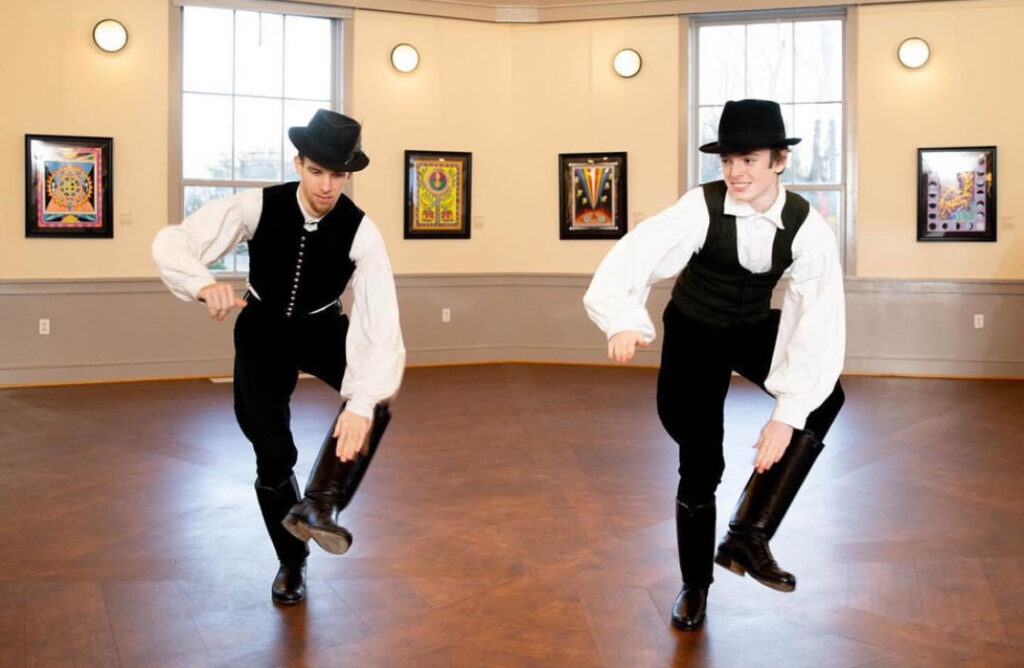
Why did you start folk dancing and teaching folk dance?
When we lived in Budapest, I attended a music school in Krisztinaváros—what we call a ‘music magnet school’ in the U.S. I played the violin and folk dancing was compulsory. I have to admit I hated folk dancing—because it was required. There is an iconic photo of me in a folk costume where I look absolutely miserable. The irony of it. Once I transferred to the Trefort School in Pest, things kind of slowed down in the dance area, and stopped altogether when we came to the States. There just wasn’t an opportunity. Here, I picked up ballroom dancing, swing, Latin and contra. I also played a heck of a lot of tennis—that was my thing. Bálint and I were very focused—we competed and practiced many hours a day on the local public courts growing up. We didn’t have much, but what we had we took to its potential. We learned about freedom but also discipline and commitment.
While living and teaching in Upstate New York, I played in a folk band for a bit. To this day, I have a deep love for dance, music and sports. None of us are ever too old or limited to try something new. We can live many lifetimes in one life. As soon as we stick to defining ourselves by our likes and dislikes, opinions, activities, our identity quickly becomes limited—and we have built a coffin around ourselves. That’s kind of the way Hungarian folk dancing slipped into our lives. When Leó became old enough we started going to Csipke Tábor (Lace Camp) and other folk programs. He’s also been working with János Szűcs since 2021 or so. I started to dance with the Tisza Ensemble, not long after he did. Leó is an amazing human being and dancer. It’s nothing Ray and I did, thankfully—as parents the only thing we can hope for is that we don’t ruin a perfect creation by programming them with our nonsense and innate ignorance.
‘Young people have tremendous energy, vibe, joy, and goodness—it’s a privilege to be around them’
One thing led to another, and I now serve the Bátori Folk Dance Ensemble. These young people are amazing, and scoutmaster Éva Dömötörffy and former leader Adrienne Myslenski as well. The ensemble took a trip last year to New Jersey as a group and I haven’t had that much fun in years. Young people have tremendous energy, vibe, joy, and goodness—it’s a privilege to be around them. As in most Hungarian communities within the diaspora, it’s not always the ‘qualified’ person who does something but the person most willing. I’d say I am just a teeny tiny part of that willing coalition. It’s amazing what energy, drive people have in the various global communities—and the commitment to keep the culture and traditions alive.
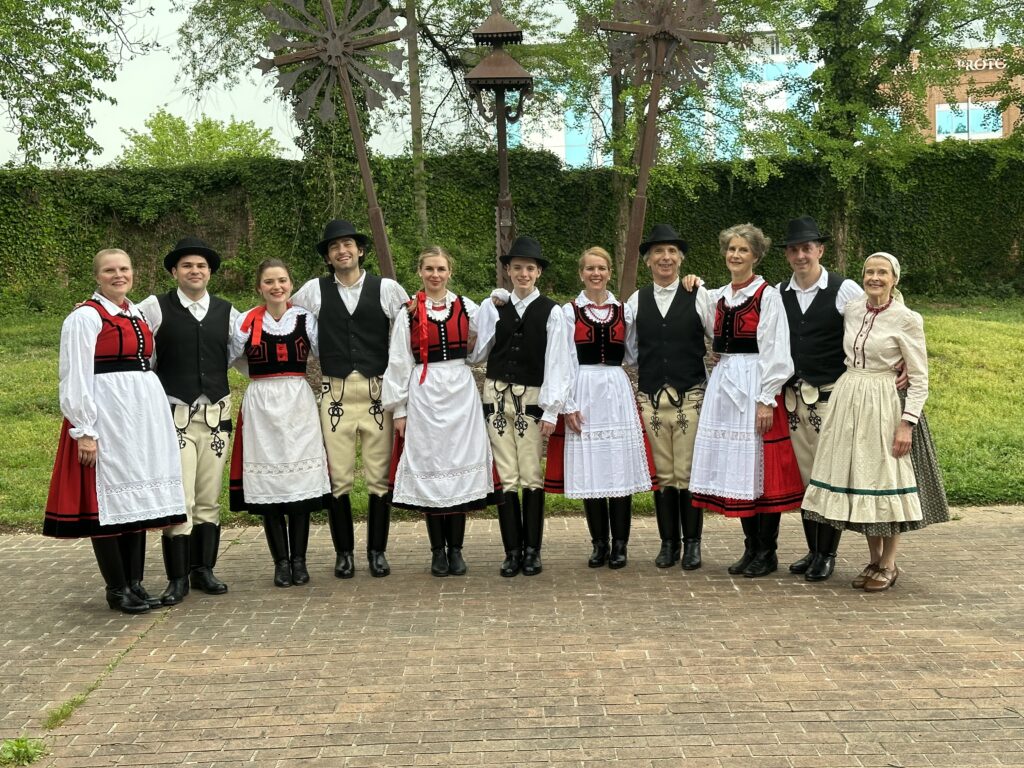
Tisza Ensemble has an interesting history. Tell us some details about it.
The ensemble has been around for 42 years, which is a record. It was founded by Cathy Lamont and her husband Rudy Petke—two enterprising Americans who fell down the endless rabbit hole of Hungarian folk dancing. You know, every ensemble is an organism and often assumes the personality of its leader. And to this day, there is a sense of joy that we all experience thanks to Cathy, who just turned 80 years old. She has the same happy and joyful vibe that she had decades ago. That’s what happens when you dance, move your body, share community and live gratefully. We’ve been (with Leó) with them for about five years, in various roles.
How long have you been involved with the Kőrösi Csoma Sándor Program as a mentor? What experiences have you had with the scholars so far?
I learned about the KCSP a couple of years ago from my friend and now colleague Szűcs Jani. With his encouragement, I applied for a KCSP pair for Tisza. We also worked with the DC Scouts, as they also needed to reboot their youth folk dance group, which hadn’t operated since about 2018. Bringing overseas teachers and choreographies is a very expensive endeavor, and we were all in need of new information, techniques and material. The process of getting your first KCSP would test anyone’s mettle. The KCSP office was very supportive, but the logistics (lodging, transportation, etc.) of hosting someone is complicated and intense—and anything you do the first time has a steep learning curve. I felt a tremendous responsibility for making sure the second-ever fully dedicated folk dance KCSP scholar had a positive impact and experience here. Last year we ended up sharing Bence Hajdu with the Hungarian American Coalition. (Bence’s pair, Kíra Kertész went to Seattle.) I have to tip my hat to Andrea Lauer Rice who often yielded her time with Bence for worthy folklife causes—we are incredibly grateful to her for that. She was an amazing partner in this new adventure.
Having worked with teams of folks over the years, it was also important to take the mentoring role seriously. That meant providing lots of opportunities for professional development, job sculpting, and networking. I made sure that Bence travelled, met people, connected with others, and experienced the fullness of the diaspora here in North America. To fully appreciate his work, you have to give back—provide opportunities for learning and professional growth. So that when he goes home, he is stronger, a more effective leader, and a more knowledgeable and empathetic human being. There are profound skills embedded in having a cultural immersion like the KCSP program. We went to Canada, Chicago, Detroit, the Carolinas, New York, New Jersey, and Csipke Tábor. He was also able to go to Seattle through an exchange agreement with Tibor Horváth of the Forgatós Ensemble. Bence and Kíra taught there and also came here to perform at last November’s Hungarian Bazaar. I also spent 20 hours in the car with them driving back and forth to Csipke. That was a bonding experience, too.
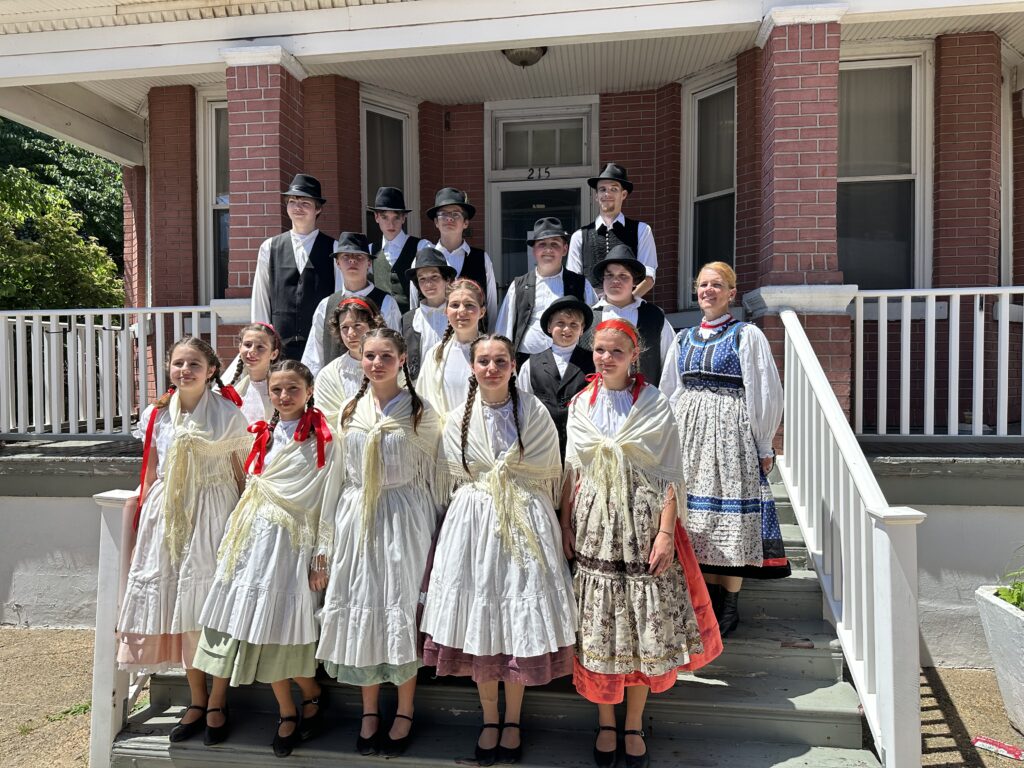
How did the idea of the Hungarian Folklife Association (HFA) come about and what has happened since its foundation?
The Hungarian Folklife Association was a concept conceived by a group of us—Szűcs Jani, me, Kálmán ‘Öcsi’ Magyar and Noemi Toka—after grassroots conversations with various communities. What we heard was nothing new: the folklife community shared common challenges, opportunities and experiences. Some of the issues were existential, such as recruitment, retention and funding. Other things were more logistical: costumes, financial management, where to find new and affordable choreographies and teachers. Apparently, it was the time to combine resources, share information and provide a platform for communication, collaboration, professional development and support.
‘That’s the human experience: we are so much happier working and living together’
This gives me an opportunity to send a shout out to my HFA colleagues. We work well together because there’s healthy unity, collaboration and an exchange of ideas. A wise person once told me that human beings are innately designed to exist in community or communion with others. Flying solo causes great unhappiness, it’s almost against nature. We are all just a part of a large brain or super organism. Bees—which I have been keeping in the last two years—have taught me a lot about this. That’s the human experience: we are so much happier working and living together. What we’ve been able to do together in the past 2+ years with our friends and colleagues in the global folklife network is inspiring. Our newly minted Board is similarly full of impressive individuals: Liz Kovach (Canada), Tomohiko Yamaguchi (Japan), Eduardo Bonapartian (Argentina) and Attila Egyedi (USA).
This November, we will host our third Annual Conference in Winnipeg, Manitoba. Thanks to Liz Kovach and Robert Langtry of the Kapitsztrán Ensemble, we will have a superb location and host city, along with an amazing line-up of speakers.
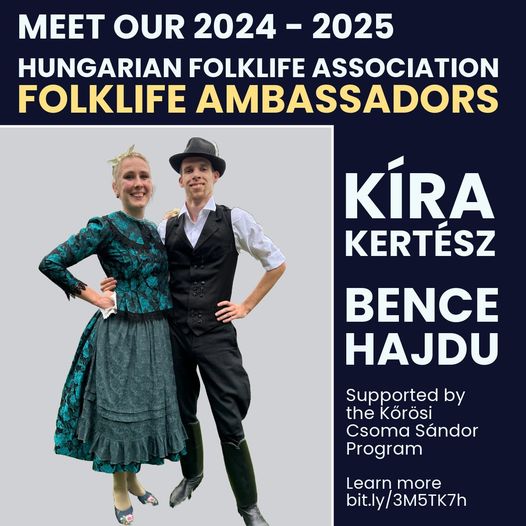
You have recently established the HFA’s Folk Ambassador status as a new KCSP model. What’s the main goal and how do you plan to implement it?
Through these cross-continent travels with Bence, I started to observe the disparities in resources and personnel within the smaller diasporal communities. Overseas there are really three avenues to connect young people to their Hungarian identity: Hungarian weekend schools, scouting and folklife. In smaller communities, one or the other is often missing simply because of resource issues. It’s not for lack of desire, willingness, or interest—access to folklife is simply not available. If you don’t have a folk dance ensemble, you have no reason to have a KCSP scholar for a year, right? And even if you could, where would they live at a reduced cost? How would they get around? Someone has to be responsible for these costs and commitments. It’s imperative to assemble a set of support systems for this valuable gift from the Hungarian government. And it was in listening to these folks that the idea came: why not provide a platform for sharing a resource across these smaller organizations and communities.
‘They get on a plane and make the magic happen on site’
In our model, the Ambassadors are like ‘rock stars’ and HFA manages their programs. We want them to be successful and focus on the things they are good at, i.e. folklife programs. We handle all the paperwork, logistics and administration with the communities. They get on a plane and make the magic happen on site. The locations where they go are strategically chosen by HFA after communities apply. To ensure program quality, we have certain requirements and principles (behind the scenes), and we want to be thoughtful and deliberate about them. Over the summer, we started mapping out the process for our Ambassadors. We have an application for diasporas to obtain their services. Once the application is accepted, we work on a Collaborative Agreement to make sure everyone is happy with the outcome. And of course, we are very interested in assessment. That’s how programs remain agile, transparent and healthy. We want to be good stewards of the resources we received from KCSP. Through this program, we also get to work with amazing people in these smaller communities. Within the U.S. and Canada, it’s been a tremendous privilege to work with folks like Jani Perge from Boston, Andi Szibrik and Tibor Horváth from Seattle, Zsuzsi Kozma from the Carolinas, Izabella Kojic Szabó, Anikó Mertkert, Erzsi Krajcz from Michigan/Ontario, Erika Klatyik from Florida, and Gabi Sinka from Minnesota. They have been the willing ‘test sites’ for this new program and have become part of our team as each program is assembled, doing everything with good cheer, grace, kindness, passion and energy. In the program’s inaugural year, having partners like these creates success for everyone. They are as invested in Bence and Kíra’s success as we are—and that’s the magic formula. So many phone calls, text messages and emails, and nothing but support on the other end. So a big thank you to them.
The first Folk Ambassadors are Kíra Kertész and Bence Hajdu. Why them?
There are a lot of reasons why Kíra and Bence were a great choice. They complement each other very well—in how they teach, perform, organize and communicate. Together, they are stronger. Having known each other for more than eight years, they can handle a lot of things together that others might not. Being overseas tests people—personally, professionally, and culturally. Being without your support system has consequences for your mental and physical health. It also pushes the boundaries of relationships and having a good baseline connection between two people provides more stability through those ups and downs, which do come in waves. All of this matters when you spend 9+ months with someone.
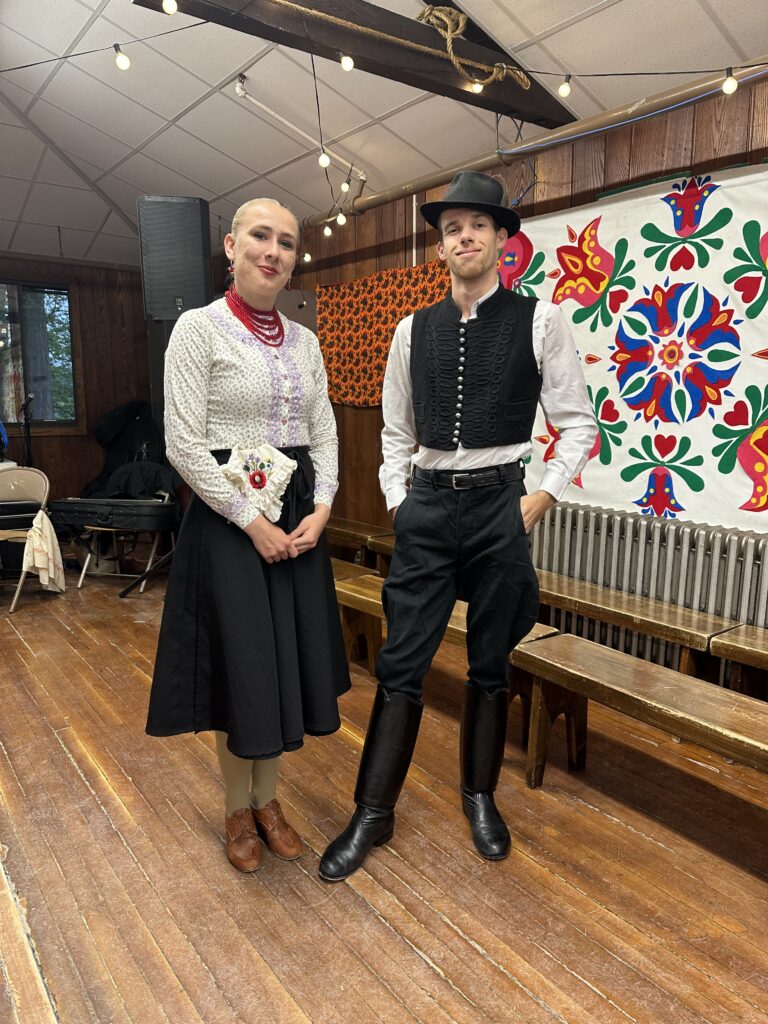
Kíra and Bence also have experience this program needed: the ability to teach, perform and build community with youth and adults. Communities really have a lot of options in terms of what they can apply for: a workshop, a mini camp, performances, folk crafts and singing. If they have the resources, it is also an option to have a new choreography. On top of that, Kíra and Bence can run a dance hall (táncház) program. In return for their efforts, we are providing them with mentoring and professional development. They are taking a suite of courses as part of our Certificate of Folklife Program Management. Through this program designed by HFA directly for the Ambassadors, they will acquire new skills in volunteer management, finance, budgeting, conflict resolution, project management, supervision, communication/marketing and a lot of other critical areas. As educators, we have to be responsible for their career advancement while they are with us—such that they go home more ready for what’s next. I really do believe that Kíra and Bence are well-positioned to be leaders in the folklife movement in the Carpathian region if they so choose. KCSP and HFA are invested in their success, and their experience here is remarkable and life-changing. To be young and have these opportunities means you are responsible for more. There is a sense of obligation that comes with more knowledge and exposure.
Meanwhile, we are already thinking about next year. Beyond the search for qualified folk dance (and maybe a little music) professionals, we also look for individuals who are open. We have a lot of requests coming at us, and flexibility is key. It’s also important to be coachable and approachable—knowledge and talent aren’t enough. We need to be able to work and learn with them. It’s been my experience that if you aren’t coachable and approachable, people simply won’t give you constructive (or any) feedback. And in the long run, you will become an island. So we need Ambassadors who enjoy the collaborative process.
What are your exact plans for the first year? Can organizations still apply for hosting them if interested?
Our hope this year is for the Ambassadors to help ten different communities. This fall, they will go to Boston, Florida, Windsor/Detroit, Seattle, and Minnesota. It’s very exciting and life-changing for everyone involved. We’ve been able to connect with Nova Scotia, the Carolinas, Phoenix and many other communities for the spring semester. Until November, we are still open for any other interested communities. Quality matters and doing too much can be unhelpful, both to the Ambassadors’ physical/mental health as well as the programs themselves. There’s a fine balance that we have to achieve and maintain. Feedback and assessment is a critical piece of this—listening to the communities, KCSP and the Ambassadors, learning, changing how we do things so that we don’t lose sight of what this is really about: bridging a resource gap and reimagining folklife resources.
This collaboration with KCSP really comes full circle for me as well. When I was growing up in Massachusetts, we were very much an island as Hungarians. And for many years, while we spoke Hungarian at home, we felt disconnected. We had very little social capital. Hopefully, helping these small communities gain access to folklife helps their recruitment and retention efforts—especially of young people—and provides an element of stability. All of us in HFA and the broader folklife community would love to see new and also existing folk dance and music ensembles thrive.
Read more Diaspora interviews:

